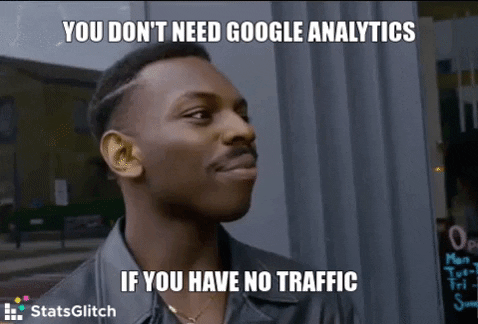Content marketing matters.
Period.
Full stop.
Exclamation point!
At first, it shocked me to find out that only 73% of B2B marketers and 70% of B2C marketers use content marketing as a part of their strategies. While the number may sound high, we believe that this type of long-form content should be incorporated into every marketing strategy.
What is content marketing?
Content marketing is a strategic marketing approach focused on creating, publishing, and distributing valuable, relevant, and consistent content. The aim is to attract and engage a clearly defined audience, driving profitable customer action.
Instead of pitching your products or services directly to consumers, marketers use this tactic as a different approach. Instead, you provide useful and relevant content to your prospects and customers, trying to offer a solution to their problems. This is often done through blog posts, videos, social media updates, infographics, podcasts, newsletters, ebooks, whitepapers, guides or webinars.
While you’re not making a direct sales pitch, if your content happens to result in a sale, it’s a huge bonus!

What are the benefits of content marketing?
- Increased Brand Visibility: Quality content can help improve your brand’s visibility both online and offline. It can help increase your search engine rankings and social media presence.
- Building Trust and Credibility: Credibility = Consistency. By consistently providing useful and informative content, you can establish your brand as an authority in your industry. This helps build trust and credibility with your audience.
- Lead Generation: 67% of marketers are currently using content marketing to help with lead generation, with 56% of them claiming its effectiveness.
- Cost-Effective: Content marketing generates over three times as many leads as outbound marketing and costs 62% less.
- Improved SEO: Quality content is vital for SEO. The more relevant and valuable content you have on your site, the better your chances of ranking higher on the search engine results page (SERP). Longer content pieces also help keep readers engaged, meaning they will spend more time on your site. This in turn helps reduce bounce rates.
- Customer Engagement: Good content encourages engagement. You’re offering new ways for customers to interact with your brand. This could be through comments, likes, shares, etc.
- Customer Education: Your content can be used to educate your customers about your products and services. You can also use it to provide useful information about your industry. This can remove any doubts or misconceptions they might have, and help them to make informed purchasing decisions.

What are KPIs?
KPIs, or Key Performance Indicators, are metrics used to measure the success and efficiency of marketing campaigns. They help to understand how well a campaign is doing against its goals. When it comes to content marketing, KPIs can help determine if your content strategy is working and how it can be improved. Businesses can then evaluate their success in reaching targets across different marketing campaigns and channels.
Why is it important to track your content marketing KPIs?
Identifying improvement areas
Monitoring your content marketing performance helps to identify which types of content appeal to different consumers. It’ll give valuable data insight into which distribution channels are performing well, and which ones need to be rethought.
Analyzing customer data and feedback helps marketers make more data-driven decisions in order to:
- optimize their content strategy
- improve engagement, and
- increase the effectiveness of their campaigns.
ROI tracking
Before marketers can effectively implement a content marketing strategy, they need to allocate the necessary resources. This includes time, money, and effort.
In monitoring their content marketing performance, marketers can assess the return on investment of their efforts. They do this by analyzing metrics related to lead generation, customer acquisition, and revenue generation. From there, they can determine the impact that these activities have on the bottom line. This will show them whether or not the investment has been worthwhile. What’s more, these figures can help in justifying the value of content marketing to stakeholders, potentially helping secure future resources and budget allocations.
Audience insights
Monitoring the performance of content helps in gaining insights into the preferences, interests, and behaviors of an audience. Some of the most valuable information is gathered from consumer buying behavior. This valuable information can help tailor future content in a way that makes it more targeted and effective.
Understanding which forms of content resonate with consumer segments greatly helps to increase engagement, brand loyalty, and customer satisfaction.
Competitive analysis
When it comes to monitoring performance, we aren’t just referring to your own strategies. Marketers should pay close attention to the tactics their competitors are using.
With the help of AI analytics, content marketers are able to compare their efforts with the benchmarks of their competitors. Analyzing the performance of your competitors’ content helps you identify potential gaps in the market. You’ll also be able to assess their competitive positioning, while showing which areas of your own strategy may be needing improvement.
Measuring effectiveness
What is the point of monitoring your performance data?
It allows marketers to assess how well their content is performing. They need to know whether their content is having the desired effect and achieving predetermined goals.
Is it driving website traffic?
Is it helping increase brand awareness, and generating leads or sales?
In a nutshell – It helps determine if the content is resonating with the target audience and achieving its intended goals.
Now that we have a better understanding of the basics, you may be wondering where to start with your content marketing KPIs. Don’t worry, we’re here to guide you through it!

7 Content Marketing KPIs You Should be Tracking:
1. Website Traffic
As we all know, website traffic is the number of people who’ve visited your website. The goal of all digital marketing should be to drive traffic to your website. This is regarded as your “home” online, since it’s the piece of digital space that belongs to your business.
Marketers can decide which traffic is better suited to their evaluations, whether that’s:
- Overall site visitors
- Specific to each page visited, and
- Organic traffic.
Most marketers consider organic traffic to be one of the most important KPIs to monitor. This is the number of viewers that visited your page on their own, without being sent there. Basically, these are the people who found your website on their own. If people are managing to find you without the help of PPC and CTAs from marketing campaigns, then it appears you’re doing something right. Oftentimes this means that search engines are making your content easily accessible and visible for searchers, and you’re ranking higher for more keywords and phrases.
While a large amount of traffic is what we’re after, there are a lot of other factors that need to be considered to determine whether or not the traffic is making a difference to our bottom line or not.
Tips for success:
- Optimize your keywords.
- Make sure the content you’re generating is always trending and engaging.
- Create more targeted landing pages.
- Use PPC marketing.
- Establish credible and appropriate backlinks.

2. Conversion Rate
A website’s conversion rate is the number of visitors that performed a desired or specific action. These are the people who clicked on your call-to-action (CTA) and were “converted” into more than just visitors. Without conversions, the people who are viewing your website are simply visiting. They’re not making purchases, asking questions, or signing up for a newsletter. At the end of the day, they’re having no impact on your ROI.
Not yet, anyway..
On average, a good conversion rate is considered to be between 2.5-3% for ecommerce sites. If you want to increase your site’s conversion rate, then you need to adopt a new optimization strategy. Most UX designers choose to optimize landing pages, pricing pages, blogs and home pages. This is done through text-based CTAs within pieces of content, testing landing pages for bugs and effectiveness, and building custom workflows to enhance team efficiency.
Tips for success:
- Gain a better understanding of your target audience.
- Pay close attention to customer feedback and reviews.
- Make sure to optimize UX throughout your website.

3. SEO and Keyword Ranking
If you want your content marketing to play a role in how well you rank on search engines, you can’t do it without SEO. While research and engaging, relevant content are the backbone of good marketing, it’s not going to be as effective when used on its own. Put SEO and content marketing together and you may just have a recipe for rankings!
Let’s break down their roles a little further:
- SEO is what will help drive traffic to your website. Most marketers tend to alter their content to incorporate SEO rather than the other way around. This includes optimizing keywords, adding appropriate inbound links, using images with alt text, and so on.
- The content is what will actually keep the audience engaged while visiting your website. It’s what builds trust, while establishing credibility and authority.
Content takes time, effort and resources to generate. It takes market research, audience analysis, brainstorming and a whole lot of creativity to create content that resonates with consumers.
It would be a shame if all that time and energy was wasted, wouldn’t it?
Consider SEO a safety net of sorts. When you create content that is reliable and relevant, you need to take it a step further by incorporating SEO. This will help audiences find your content more easily, as it increases visibility and brand awareness. Thanks to the basic guidelines for SEO practices, it also plays a role in enhancing your site’s user experience.
Tips for success:
- Optimize your chosen keywords.
- Use appropriate, value-adding links.
- Focus on the UI behind searches.
- Track your keyword ranking.

4. Social Shares
As the name suggests, social sharing is the act of sharing content across social media channels through group chats, links, comments; the works.
The main goal here is to create brand awareness and extend the reach of the content. Many businesses with online profiles favor this type of marketing because technically, it’s organic. The wider audience is promoting the content on your behalf, with or without additional costs involved (we’re talking influencer marketing).
This marketing tactic has huge benefits for the organization – content that’s received from close connections, i.e. friends and family, or from trusted sources like influencers and celebrities that you admire, is far more welcomed than that from external sources.
Tips for success:
- Make sure to use suitable marketing channels for reaching your target audience.
- Create meaningful, relatable content.
- Engage with users as much as possible through shares, likes and comments.
- With this marketing form, consistency is key.

5. Lead Generation
Before jumping into how marketers generate leads through content marketing, we need to make sure you have a basic understanding of what lead generation entails.
Lead generation is defined as the process of identifying and nurturing potential customers for your product or service. It’s how marketers generate interest in the offering that will hopefully turn into a sale later on down the sales funnel.
One of the most popular methods of generating leads through content marketing is with the use of persona targeting. This effective strategy involves researching your target audience and segmenting them according to lifestyle, behavior and needs. From there, you develop specific client personas according to their challenges and goals. This will give you a better idea of who your audience is and how to target them. You can then tailor your content to suit their needs and answer their questions to make sure it is as relevant and effective as possible.
Tips for success:
- Have a good understanding of your target audience.
- Actively promote your content once it’s created.
- Post your content on suitable channels for reaching your target audience.
- Personalize your content to your personas.
- Take advantage of visuals in your content.

6. Bounce Rate
Let’s make sure our understanding of bounce rates is clear before we move on to how to improve them. Here’s what specifically dictates a “bounce”:
- The visitor clicks “back”
- The visitor closes the tab/browser
- An external link is clicked
- No other page is clicked within 30 minutes
Basically, a bounce is a visit that didn’t result in an action being taken, whether that’s subscribing, clicking a link or making a purchase. It’s the number of people who visit a page, and leave through that same page without visiting anything else.
High bounce rates tend to be an indication that the content you’re creating isn’t having the desired effect and that it needs improvement. While bounce rates are not an official ranking factor, they can offer marketers valuable insights into whether or not their content is achieving the goals previously set out.
Tips for success:
- Create an effective internal linking strategy.
- Make use of lazy loading for visuals within your content.
- Create relevant and engaging content.
- Focus on persona targeting.
- Use the Pain-Agitate-Solution method in your content creation.

7. Engagement Rate
A website’s engagement rate is how many people interact and engage with your content. This takes a number of forms, such as likes, shares, comments, link clicking, you get the point. Marketers believe that this is a direct indicator of the efficiency of your marketing efforts. Visitors who engage with your content are far more likely to convert into paying customers down the line. They often lead to referrals through word of mouth, brand awareness and credibility for businesses.
Measuring your content engagement has a number of advantages:
- You’ll gain greater insight into your audience.
- Marketers will be able to map out the user journey and adapt their marketing funnel.
- Nurturing leads is more easily achieved.
Tips for success:
- Incorporate interactive content.
- Reward engagement by offering discounts for sign ups and subscribers.
- Used personalization across marketing tactics.
- Make your content more appealing through visuals.

How do I Track my Content Marketing KPIs?
- Google Analytics: It can help monitor website traffic, bounce rate, time spent on the site, and many other metrics.
- Social Media Analytics: Social media platforms provide tools to track the engagement and shares of your content.
- SEO Tools: Tools like SEMrush and Moz can help in tracking SEO rankings.
- CRM Platforms: CRM platforms can help in tracking lead generation and conversion rates.
Using Technology for Content Marketing
Artificial intelligence (AI) is rapidly making its way into the world of digital marketing. Marketers are constantly looking for ways to use the data to improve their decision making and campaign strategies. It gives users an insider’s perspective into the minds of their consumers, and could potentially revolutionize the way you conduct your marketing efforts.
Content automation is one of the most popular uses for AI in our world or marketing. From simple automations, such as brand descriptions and Twitter announcements, to the more advanced tools, like ContentBot’s Flow builder and Imports feature.
With AI content automation, you can redefine the content creation process:
- Idea generation
- Long-form content generation
- Coding
- Market and content-related research
- Translating into multiple different language
- Proofreading
- Paraphrasing
Key points to remember…
While it may not always be easy to stay ahead of content marketing trends, generating valuable, relevant and engaging content is the foundation of any content marketing strategy. However, it’s not as effective as a standalone effort. It needs research, data, monitoring and SEO if it’s going to achieve the goals you’ve set in place.
Without monitoring your content marketing KPIs, there’s no way to determine whether or not your content has achieved the desired results. If you want to make sure you are optimizing your ROI and using resources as efficiently as possible, then tracking your KPIs is the only way to make sure your strategies stay on target. It’s the best way to stay relevant in the fast-paced world of digital marketing.
With 7 content marketing KPIs, along with a few secrets for success, you’ll be able to take your marketing to the next level. If you ask us, this marketing tactic belongs in every strategy to create a holistic approach to customer satisfaction.
And remember, technology has enormous potential to upscale your content production. From AI writers to workflow builders, you could produce consistent, high quality content in a matter of seconds. The possibilities are only limited to your imagination!

- How AI is Transforming the SEO Landscape: A Marketer’s Perspective - February 29, 2024
- How To Use AI For Keyword Research: A Marketer’s Guide - February 16, 2024
- The Impact of AI Writers on SEO Performance: Friend or Foe? - January 31, 2024
